The sun can be your worst enemy when doing certain outdoor activities – like hiking at high altitudes or cycling in summertime. Obviously, you take precautions like wearing sunscreen, a brimmed hat, and a long-sleeved UV sun shirt. But one places that often gets overlooked – and very burnt – are the hands.
There is a simple solution for sunburn on the hands: Wear sun gloves when hiking, cycling or other activities where your hands will be exposed.
Sun Clothing vs. Sunscreen
Sunscreen definitely has its benefits, but it isn’t always the smart choice for outdoor activities. For starters, it makes you feel all greasy. Even if you only apply it to the back of your hands, it still somehow makes your palms feel greasy, which in turn can screw up your grip on hiking poles or your bike. And who wants to carry around a bunch of sunscreen anyway?? Imagine how much you’d need to carry for a long bike tour or backpacking trip!
On top of that, sunscreen isn’t even effective for very long. According to this report, our skin uses up the active ingredients in sunscreen in about 2 hours. If you are sweating, then you’ll need to reapply sooner. I really don’t want to bother applying sunscreen every 1 hour.
Yes, sun clothing will make you a bit hotter. But it is much more reliable at protecting you from sunburn. So, get a good UV protection sun shirt and long pants to wear with your sun gloves. REIN has a lot of good options for sun clothing which you can see .
DIY Sun Glove Hack:
If you don’t feel like buying sun gloves, you can buy a UV sun shirt which is slightly too big. You want the sleeves to go over your hands. Then you can just cut thumb holes into the sleeves. Put the hole a bit further back than you normally would for a thumb hole. This should keep the shirt over your hands so it stays covered.
Alternatively, you could take some light-colored liner gloves and cut off the fingers at the first joint (leaving the thumb if you don’t want your thumb getting burned while hiking with poles). Wool and silk offer the best UV protection. You might have to hem them to keep them from unraveling. If you are going to go to all that trouble though, you might as well buy some sun gloves.
What to Look for in Sun Gloves
We use our hands a lot. The right pair of sun gloves will give you UV protection but still enough dexterity to perform tasks.
On the flip side, the wrong pair of sun gloves will annoy the hell out of you. You might find it difficult to do tasks like take photographs or tie knots. Or, you might find them so cumbersome and sweaty that you simply take them off.
If you aren’t wearing the sun gloves, they obviously aren’t going to provide you any UV protection. So choose your sun gloves carefully! Pay particular attention to these features:
Full Finger vs. Fingerless
Fingers usually don’t get sun burned (at least as badly as the back of the hand). So, you might not need fingers on your sun gloves if you are cycling, canoeing, or hiking without poles.
If you are hiking with poles though (which you should – here’s why), there’s a good chance that your thumb will get burned. In this case, you’ll want sun gloves with fingers. You could even cut off all the fingers except the thumb so it is protected but your fingers are still free.
Touchscreen Use?
Another thing to consider with fingers on sun gloves is whether you will be using a touchscreen. Many sun gloves with full fingers are not touchscreen compatible (the Coolibar gloves are touchscreen compatible though).
Weight vs. Durability
Ideally, the UV sun gloves should be lightweight. Light equals breathable, and also means less weight on your pack.
But lightweight also means the sun gloves will be thinner and wear out sooner. This isn’t really an issue if you are hiking without poles. For activities where your palms get used a lot (hiking with poles, canoeing, cycling, etc.), the palm part of the glove will wear out quickly. Don’t expect even the best sun gloves to last more than 1 to 2 seasons.
Palm Type
Most good sun gloves have some sort of grip on the palm. This is really useful, especially when your gloves end up wet from sweat and you still need to grasp hiking poles or your bike handles.
In general, the silicon or rubber-dot types of grip are best for hiking. For cycling, you might need a thicker, tougher grip. Leather grips are really bulky, but they will hold up longer than other sun gloves.
On the flip side, a lot of people (myself included) prefer sun gloves without any palm at all. This gives you more ventilation and allows you to wipe the sweat off your hand (my hands get insanely sweaty, even when the rest of my body isn’t sweaty). However, this comes at the expense of grip.
Angler/Fishing Gloves?
Many of the UV gloves you see sold are meant for angler fishing. These types of sun gloves can work for other outdoor sports, but they generally aren’t the best option.
Angler gloves usually have reinforced palms with leather grip (though some feature open palms). Some of the fingers might have reinforced padding too. A lot of hikers and cyclists also say that the padding makes them uncomfortable and bulky to wear.
Another problem is that angler gloves usually don’t have thumb protection. So, if you try to use them for hiking with poles (when your hand is held in supinated position), your thumb will be exposed to the sun and get burned.
Sizing
Before buying sun gloves, you will need to measure your hand circumference. Note that each brand has slightly different glove sizing. Check the product pages to see their sizing info.
Color
The color of the sun gloves isn’t just an issue of style. The color can affect the UV protection. In general, white and black sun gloves offer the highest UV protection. White are obviously going to be cooler than black gloves, but they show dirt/sweat stains really quickly.
Best Sun Gloves
All of these best sun gloves were specifically chosen for hiking and cycling, though they could work for canoeing, paddling, and a range of other outdoor sports too.
Coolibar UV Gloves
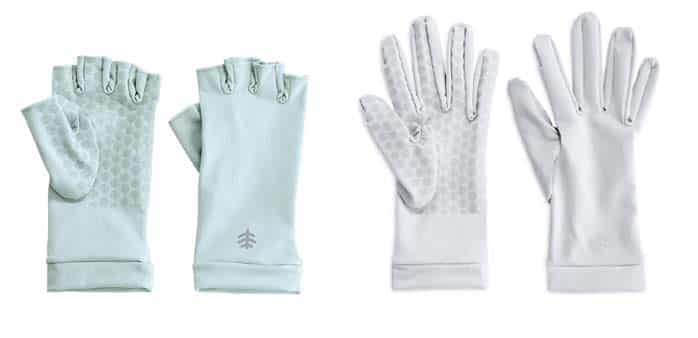
Among hikers, Coolibar UV protection gloves are by far the favorite option. They are made of a lightweight blend of polyester and spandex. They are pretty stretchy and easy to pull on. It will give you a good fit.
There is a silicon grip on the palm area. It is thin but does the job. A nice thing about the gloves are that they are touchscreen compatible, which is useful if you are taking photos with your smartphone while outdoors.
Features:
- Full finger and fingerless options
- UPF 50+
- 4-way stretch
- Cooltect wicking technology
- Silicone grip
- Touchscreen compatible
- 6 color options
- 5 sizes
- Get the fingerless gloves here and full-finger gloves here
Outdoor Research Chroma Sun Gloves
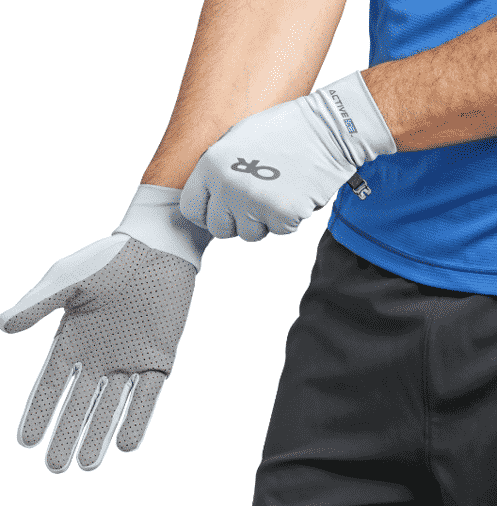
These are another favorite sun glove among hikers and has good enough grip for cycling too. The synthetic leather palm gives really good grip and means the gloves will hold up better than most others. The palm material has perforations in it, which means that it is still cool.
They are made from a material called ActiveIce. It has xylitol crystals in it which are supposed to cool you as moisture wicks away. So, the more you sweat, the cooler these gloves will be.
There is only 9% spandex in these gloves though and the palm is thick, so don’t count on them stretching too much. Make sure you measure your hands carefully before ordering.
*These aren’t Touchscreen compatible. The fingerless version is here.
Features:
- Full finger
- UPF 50+
- ActiveIce wicking material
- Perforated synthetic leather grip
- Not touchscreen compatible
- Glove clip
- Gray color
- 4 sizes
- Available at: Amazon
Outdoor Research ActiveIce Fingerless Sun Gloves
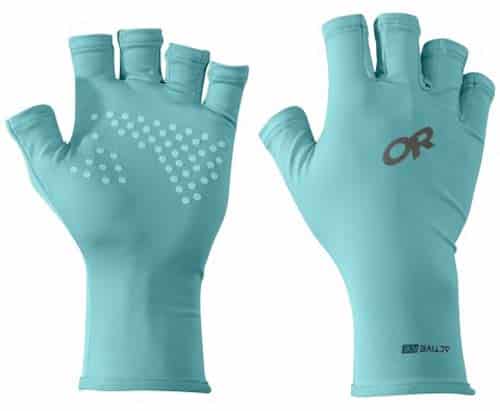
These sun gloves are also made from ActiveIce material, so they will cool you as they wick moisture away.
The difference between the OR Chroma gloves and these Spectrum gloves is in the palm. There is just a bit of silicone grip on the palms. This is good if you prioritize coolness and comfort over grip.
The material is very thin and lightweight. It will be very comfortable to wear, but don’t expect it to last as long as a sun glove with reinforced palms.
Features:
- Fingerless
- UPF 50+
- ActiveIce wicking material
- Silicone dot grip on palms
- Touchscreen compatible
- 5 colors
- 4 sizes
- Available at: Amazon
Glacier Islamorada Sun Gloves
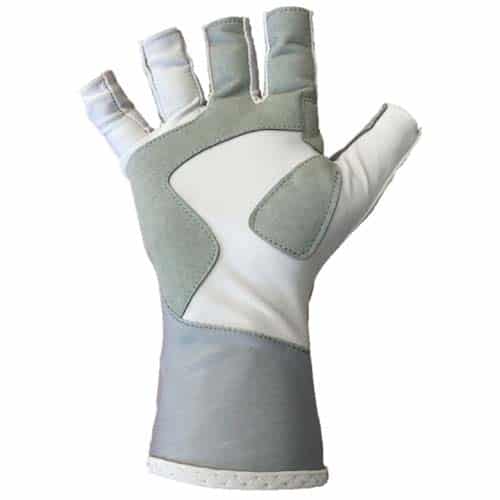
These sun gloves are designed for fishing but are popular with backpackers. Compared to other fishing sun gloves, they are lightweight and breathe pretty well (though not nearly as breathable as the Coolibar or Outdoor Research sun gloves).
The palm is reinforced in some key areas with synthetic leather, which helps them hold up against strenuous use. Since the palm is only reinforced in some areas, you still get good dexterity and breathability.
Your hands will get hot hiking in these sun gloves. However, once you start sweating and the gloves get a bit wet, they will cool down quickly.
Make sure you get a good fit with these. While the description does say “4-way stretch”, they can still be a bit difficult to put on if you size them too small.
Features:
- ¾ finger
- UPF 50+
- Quick dry material
- Synthetic leather partial palm
- Touchscreen compatible
- Gray and camo
- 5 sizes
- Available at Amazon
Tip: Avoid Velcro!
Almost all sun gloves are made from a material which sticks to Velcro. You’ll slowly ruin your sun gloves if you get them stuck to Velcro. So be cautious when opening any Velcro straps.
Resources:
https://backpackinglight.com/forums/topic/49808/
Image credit: “IMG_0170” (CC BY-NC-ND 2.0) by jr⁹⁸⁶⁶⁴


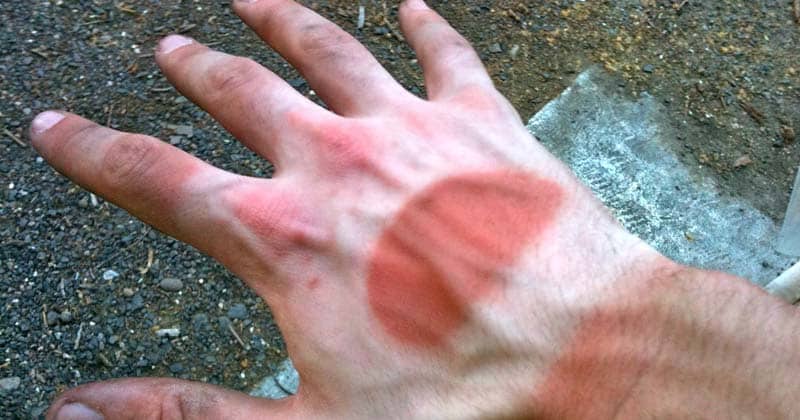










Post your comments